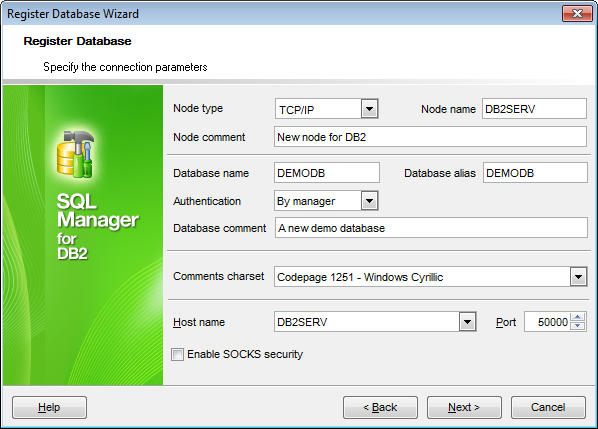Online Documentation for SQL Manager for DB2
Specifying connection parameters
Use this step of the wizard to set the necessary connection parameters for the new Node in the corresponding boxes: Node type, Node name, Node comment, Database name, Database alias, Authentication, Database comment, Comments charset and connection properties.

Node type
Select the communication protocol to be used to connect to databases on the specified Node: TCP/IP, LOCAL, APPN, Named Pipe or IPX/SPX.
- TCP/IP
If this value is selected, a Transmission Control Protocol / Internet Protocol (TCP/IP) node entry is added to the Node directory, and the TCP/IP communication protocol will be used to access the remote DB2 Node.
- LOCAL
If this value is selected, a local alias for an instance that resides on the same machine is created. A local node should be cataloged when there is more than one instance on the same workstation to be accessed from the user’s client. Interprocess Communications (IPC) will be used to access the local DB2 Node.
- APPN
If this value is selected, an APPN node entry is added to the Node directory, and the Advanced Peer-to-Peer Networking protocol will be used to access the remote DB2 Node.
- Named Pipe
If this value is selected, a named pipe node entry is added to the Node directory, and the named pipe protocol will be used to access the remote DB2 Node.
- IPX/SPX
If this value is selected, an IPX/SPX node entry is added to the Node directory, and the specific Internetwork Packet Exchange/Sequenced Packet Exchange networking protocol will be used to access the remote DB2 Node.
Set the Node name in the corresponding box, and supply a Node comment, if necessary.
Database name
Enter the database name in this box.
Database alias
Any database alias that is convenient for you (e.g. MYDEMODB). This alias will be displayed in the DB Explorer window.
Authentication
Here you are supposed to select the type of authentication to be used to access the database: By manager, Server, Client, Kerberos, Server Encrypt, DCS, DCE, DCS Encrypt or DCE Server Encrypt. Specifying an appropriate authentication type may result in a performance benefit.
- By manager
Specifies that authentication is performed by SQL Manager for DB2. Passwords are encrypted in Windows Registry.
- Server
Specifies that authentication takes place on the node containing the target database.
- Client
Specifies that authentication takes place on the node where the SQL Manager for DB2 application is invoked.
- Kerberos
Specifies that authentication takes place using Kerberos Security Mechanism.
Target principal
Enter the fully qualified Kerberos principal name for the target server; that is, the fully qualified Kerberos principal of the DB2 instance owner in the form of name/instance@REALM. For Windows 2000, Windows XP, and Windows Server 2003, this is the logon account of the DB2 server service in the form of userid@DOMAIN, userid@xxx.xxx.xxx.com or domain\userid.
- Server Encrypt
Specifies that authentication takes place on the node containing the target database, and that passwords are encrypted at the source. Passwords are decrypted at the target, as specified by the authentication type cataloged at the source.
- DCS
This value indicates that information about the remote database is stored in the Database Connection Services (DCS) directory. Access to this databases is performed with an Application Requester (AR), such as DB2 Connect, used. Having a DCS directory entry with a database name matching a database name in the system database directory invokes the specified AR to forward SQL requests to the remote server where the database resides.
- DCE
Specify this value if you wish to use DCE (IBM® Distributed Computing Environment) which provides security support for access to your DB2 database.
- DCS Encrypt
Specifies that authentication takes place on the node containing the target database, except when using DB2 Connect; in that case, authentication takes place at the DRDA application server (AS). Passwords are encrypted at the source, and decrypted at the target, as specified by the authentication type cataloged at the source.
- DCE Server Encrypt
Specify this value if you wish to use DCE (IBM® Distributed Computing Environment) which provides security support for access to your DB2 database to ensure data integrity and confidentiality on the server-side.
Supply a Database comment, if necessary.
Comments charset
Specify the character set that should be used for node and database comments.
Afterwards you should specify protocol-specific connection properties.
Depending on the selected communication protocol, you are supposed to define protocol-specific properties: Host name/Port (for TCP/IP protocol), Local/Remote partner LU, Mode (for APPN protocol), Computer name, Instance name (for Named Pipe protocol), or File server, Object name (for IPX/SPX protocol). For details see Specifying connection parameters (defined when adding a new catalog entry for node).
When you are done, click the Next button to proceed to the Setting specific options step of the wizard.



































































